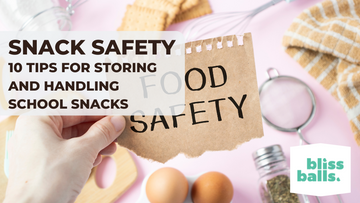Snack Safety 10 Tips for Storing and Handling School Snacks
by Hitesh singh on Apr 04, 2024

Snacks are a crucial part of the school day, providing students with the energy they need to stay focused and engaged in their studies. Whether you're packing snacks for your child or bringing them to share with the classroom, safety is key. Improperly stored or handled snacks can lead to spoilage or, worse, foodborne illnesses.
To help keep school snacks safe and enjoyable, here's a list of 10 essential tips for storing and handling snacks like Cacao Protein, Chocolate Bliss Balls, Chocolate Coconut Cream, Hemp Protein Bliss Balls, and Cranberry.
1. Choose Non-Perishable Snacks
When selecting snacks for school, opt for non-perishable items whenever possible. Snacks like Bliss Balls, which are made from dried fruits, nuts, and seeds, are ideal because they don't require refrigeration and have a longer shelf life.
2. Use Airtight Containers
Store snacks in airtight containers to prevent exposure to air and moisture, which can lead to spoilage. Make sure the lids fit securely to keep the snacks fresh and to avoid spills in backpacks or lunch bags.
3. Label and Date the Containers
Label the containers with the name of the snack and the date it was packed. This practice helps you keep track of when the snack was made and ensures you're serving the freshest possible snacks.
4. Keep Snacks Cool
Even non-perishable snacks can benefit from being kept cool. If you're packing snacks for school, consider using an insulated lunch bag with a small ice pack. This helps maintain a consistent temperature and prevents snacks from getting too warm during the day.
5. Avoid Cross-Contamination
When preparing and packing snacks, ensure you're using clean utensils and surfaces to avoid cross-contamination. If you're handling different types of snacks, use separate utensils and cutting boards to prevent mixing flavors and allergens.
6. Consider Allergies and Dietary Restrictions
When bringing snacks to school, be aware of any allergies or dietary restrictions in the classroom. Check with the teacher or school administration to ensure your snacks are safe for everyone. Bliss Balls are generally gluten-free and vegan, but always double-check the ingredients for allergens like nuts or dairy.
7. Store Snacks in a Cool, Dry Place
If you're storing snacks at home before sending them to school, choose a cool, dry place like a pantry or cupboard. Avoid storing snacks near heat sources or in direct sunlight, as this can cause them to spoil faster.
8. Keep Snacks Sealed Until Ready to Eat
Encourage students to keep their snacks sealed until they're ready to eat. This helps maintain freshness and reduces the risk of contamination. Teach them to reseal any uneaten portions to keep the snacks fresh for later.
9. Teach Proper Hand Hygiene
Before eating snacks, students should wash their hands thoroughly with soap and water. This simple step helps reduce the risk of foodborne illnesses and keeps snacks safe to eat. If washing hands isn't possible, consider packing hand sanitizer in their lunch bag.
10. Inspect Snacks Before Serving
Before serving snacks to a group or packing them for school, inspect them for any signs of spoilage, such as an unusual smell, discoloration, or mold. If you notice anything unusual, discard the snack immediately to avoid the risk of foodborne illness.
By following these 10 tips for storing and handling school snacks, you can ensure that your child has a safe and enjoyable snacking experience.
Proper storage and handling practices not only keep snacks fresh but also help prevent food-related issues, allowing students to focus on what really matters—their education and growth.
With these tips in mind, you can confidently pack snacks like Bliss Balls and other nutritious options, knowing they're safe for your child and their classmates.

